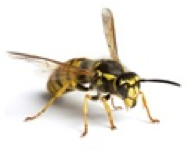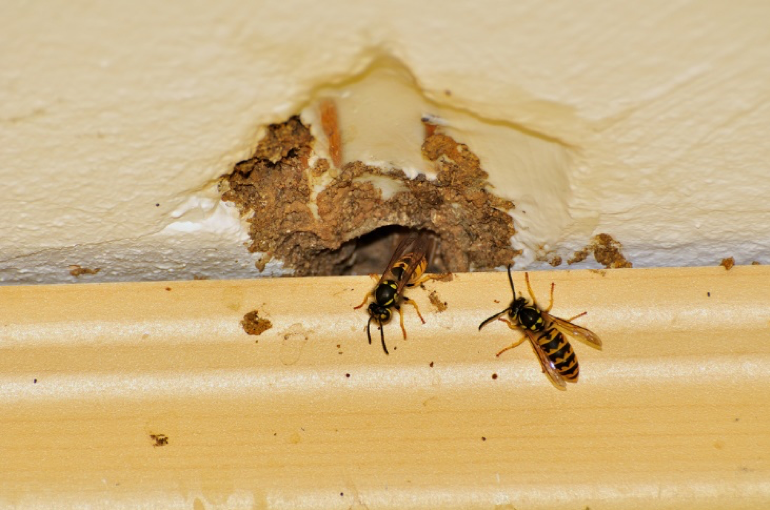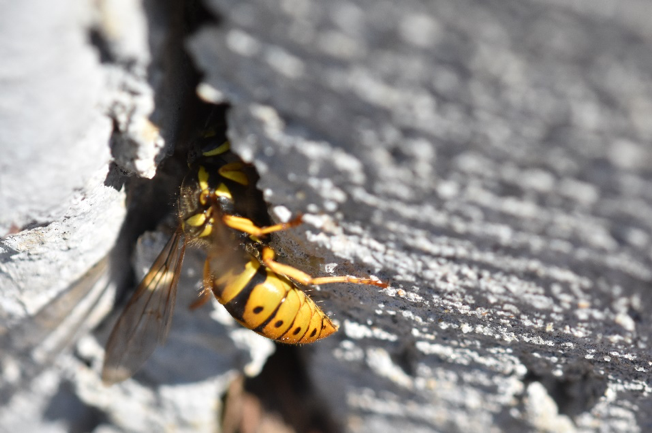 Yellow jackets are easily the most aggressive stinging insect in Tallahassee. You can identify them by their long narrow waist, covered in black and yellow stripes. They are very small wasps, measuring only ½ inch long. Yellow jackets are social insects that live in nests or colonies with up to 4,000 workers. They feed on sweets and proteins, and therefore commonly invade outdoor events.
Yellow jackets are easily the most aggressive stinging insect in Tallahassee. You can identify them by their long narrow waist, covered in black and yellow stripes. They are very small wasps, measuring only ½ inch long. Yellow jackets are social insects that live in nests or colonies with up to 4,000 workers. They feed on sweets and proteins, and therefore commonly invade outdoor events.
Yellow jackets nest in wall voids, attics, and in the ground outdoors. Their nesting behavior can be startling if they start flying indoors with no warning. Yellow jackets have the ability to come in from outdoors, access wall voids, and fly around your house. Another unfortunate but common situation can happen if yellow jackets are nesting in the ground on your property. If you don’t notice their activity, you can easily run their nest over with a lawnmower or step directly on it with flip flops or even worse, bare feet.
Why do I have yellow jackets?

Yellow jackets can be found anywhere humans are found. They build paper carton nests out of chewed up cellulose, which are usually found in the ground or in cavernous areas such as eaves and attics. Your property can be appealing to yellow jackets when they find an abundant food source. Nests grow where it’s easier for them to thrive. Attics are another ideal space for yellow jacket nesting. Within attics, yellow jackets can travel in and out, being in the sun during the day and nesting in a protected area overnight. Broken vents, openings around fascia boards, and small cracks and crevices allow them to fly in and nest.
Are yellow jackets dangerous?
Yes, yellow jackets are dangerous if disturbed. They have the ability to sting multiple times and will defend their nests if they feel threatened. As the summer season comes to an end, they become more aggressive due to the fact that many are dying off as their natural food sources die.
Can I get rid of yellow jackets on my own?
If you go on YouTube or search on Google for ways to get rid of yellow jackets at home, you’ll probably come across the following “effective” solutions that don’t involve professional pest control services.Yellow jackets can be found anywhere humans are found. They build paper carton nests out of chewed up cellulose, which are usually found in the ground or in cavernous areas such as eaves and attics. Your property can be appealing to yellow jackets when they find an abundant food source. Nests grow where it’s easier for them to thrive. Attics are another ideal space for yellow jacket nesting. Within attics, yellow jackets can travel in and out, being in the sun during the day and nesting in a protected area overnight. Broken vents, openings around fascia boards, and small cracks and crevices allow them to fly in and nest.
- Gasoline poured into the nest entrance
- Store bought repellent sprays
- Bleach and Ammonia mixture poured into the nest entrance: EXTREMELY DANGEROUS
- Boiling water dumped into the entrance of the nest
Most of the DIY remedies suggest that homeowners get in close contact with the yellow jacket nests to spray or dump the solution into the nest, however, this can be extremely dangerous. Yellow jackets are one of the most aggressive wasps who will stop at nothing to protect their nest. You should never get near a yellow jacket nest without the proper safety gear on otherwise you’re subjecting yourself to the possibility of getting stung multiple times.
Not only is it extremely unsafe to treat for stinging insects on your own, but if the nest within the walls of your home, your efforts in eradicating the insect may actually be making the problem even worse, to a point where it is even difficult for pest professionals to solve the problem. If you have a nest within a wall void of your home and you decide to self-treat the yellow jackets by spraying an aerosol spray inside the entrance of the nest, you can force the yellow jackets further into your home.
How can I prevent yellow jackets at my home?

Yellow jackets are attracted to sweets. During the hottest time of year, they search for open cans of soda and sweets left out at your family barbecue or outdoor party. Keep food and beverages covered to avoid swallowing yellow jackets instead of Pepsi. Do you leave your trashcans open outside? Do your trashcans have holes from wildlife break-ins? Tightly secure all trashcans and replace those that have entry points even when closed. Yellow jackets will hover over open trashcans and sting if you disturb them. Repair broken attic and gable vents. Yellow jackets often nest in attics. Sealing up any entry points will bar them from entering.
How can I avoid getting stung by yellow jackets?
Allergists-immunologists recommend the following additional precautions to avoid all stinging insects, including wasps and yellow jackets:
- Avoid wearing sandals or walking barefoot in the grass. Honeybees and bumblebees forage on white clover, a weed that grows in lawns throughout the country.
- Never swat at a flying insect. If need be, gently brush it aside or patiently wait for it to leave.
- Do not drink from open beverage cans outdoors. Stinging insects will crawl inside a can attracted by the sweet beverage.
- When eating outdoors, try to keep food covered at all times.
- Garbage cans stored outside should be covered with tight-fitting lids.
- Avoid sweet-smelling perfumes, hair sprays, colognes and deodorants.
- Avoid wearing bright-colored clothing.
- Yard work and gardening should be done with caution. Wearing shoes and socks and using work gloves will prevent stings on hands and feet and provide time to get away from an unexpected mound.
- Keep window and door screens in good repair.
- Drive with car windows closed.
- Keep prescribed medications handy at all times and follow the attached instructions if you are stung. These medications are for immediate emergency use while en route to a hospital emergency room for observation and further treatment.
- If you have had an allergic reaction to an insect sting, it’s important that you see an allergist-immunologist.
What Are Yellow Jackets Termite and Pest Control in Tallahassee FL?
Serving Your Pest Needs for over 50 years in Tallahassee FL
